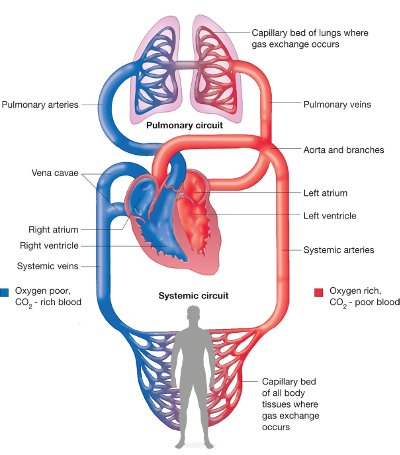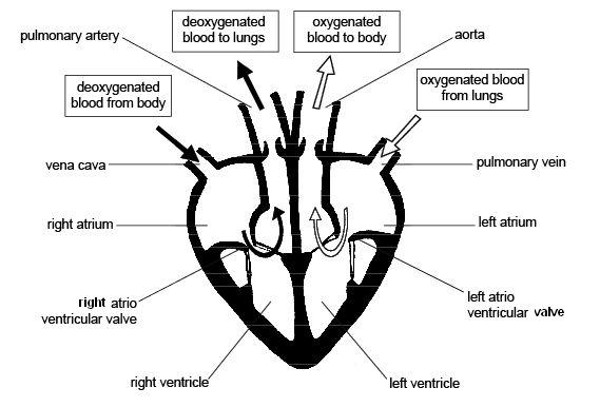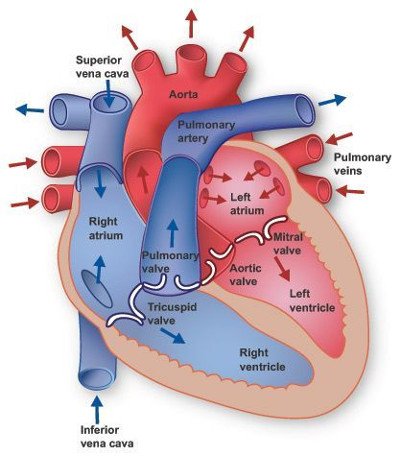Human Anatomy 101 - The Heart (Basics)
G'day team,
This article will require a working understanding of anatomical terminology. If you haven't read my posts on understanding anatomical terminology you can find them here
Anatomy 101 - Anatomical Terminology (Basics)
Anatomy 101 - Anatomical Terminology (Detailed)
Today we'll be having a chat about one of the most vital organs in the body, the heart!

Image source
So let's get started...
Basics of Bloodflow
Now the blood that supplies every part of our body is pumped by a single central muscle, the heart. But did you know that we have two separate circulatory systems in our body? Our circulation actually works in a "figure-eight" configuration with the heart at the center. This ensures that not only does blood reach every part of our body, but that it's oxygenated when it gets there.
Let's have a look at how this works.
Starting at the LEFT side of the heart, we have oxygen-rich blood which is pumped to the entire body. As it travels throughout all of our tissues the oxygen is picked up from our blood and when it next returns to the RIGHT side of the heart it is 'deoxygenated'. From here the RIGHT side of the heart pumps blood to our lungs where it picks up oxygen and returns back to the LEFT side of the heart, fully oxygenated and ready for another round!
Now look at the diagram below... start at the right side of the heart and trace your way around till you're back at your starting point!

Image source
Structure of the Heart
Despite its insane importance in our body, the heart has a relatively simple structure. Each side of the heart works as a pump, with a two-chamber mechanism to ensure there's no backflow or loss of power.

Image source
First blood enters the atria, where it pools before a contraction pushes it into the ventricles. When the ventricles fill a valve closes, preventing blood from flowing back into the atria. From here the ventricle contract and push the blood to the rest of the body, and another valve prevents blood flowing back into the heart.
You should pay attention to the following parts of the heart...
Left Side of the Heart
- Left atria - pumps to the left ventricle
- Left ventricle - pumps to the body
- Mitral valve - between the left atria and left ventricle
- Aortic valve - between the left ventricle and the aorta
Right Side of the Heart
- Right atria - pumps to the right ventricle
- Right ventricle - pumps to the lungs
- Tricuspid valve - between the right atria and right ventricle
- Pulmonary valve - between the right ventricle and the pulmonary artery

Image source
The Coronary Arteries
Now the first important organ that the heart has to supply blood to is itself! And there are a special set of arteries that are designed especially for this purpose.
The coronary vessels come straight from the main systemic artery of the heart, the aorta. Unlike every other artery in the body, the coronary arteries fill while the heart relaxes.

Image source
When a coronary artery is blocked muscle tissue no longer receives the blood supply it needs to stay alive. This leads to the all too well -known phenomenon of a heart attack (myocardial infarct).
Cardiac Conduction
Finally, the special way that the heart beats is the result of an incredibly well-developed system of cells that conduct a contractive signal out through heart tissue. The sinoatrial (SA) node found on the right atrium sets the pace for contractions of the heart. From here s string of conductive cells spread the impulse across the atria which contract first, and then to another node that sits between the atrium and ventricles called the atrioventricular (AV) node. The signal then passes down the center of the heart before spreading out over the left and right ventricles causing them to contract and pump blood to the lungs and body.

Image source
Thanks
That's it team! Thanks for reading up on the anatomy of the heart, I hope you enjoyed learning! Keep posted for my next post which will cover more details of the hearts anatomy and some of they key parts of physiology that allow it to work!
Thanks
-tfc
Resources
Texas Heart Institute
Inner Body
Excellent article for a layman who just likes stuff like this, so thank you, but I have a question.
Its about the mechanics of gas exchange, is it an even good gas in and good gas out or is it all happening at the same time, especially in reference to the lungs ?
Thanks
So if I understand your question correctly then you're asking about gas exchange in the lungs?
When blood reaches the lungs, it doesn't have much oxygen in it. The blood is very close to the air in the alveoli and as such a concentration gradient is in place, meaning oxygen can passively diffuse across into the blood.
At the same time, as blood reaches the lungs it's high in CO2. This is a 'bad' gas and it diffuses OUT of the blood and into the air in the lungs at the same time.
Now as blood travels around the body the oxygen it's picked up in the lungs slowly leaves the blood and enters the cells. In the cell's the oxygen is 'used' and converted to CO2 which is picked up and brought back to the lungs.
Does this answer your question? :)
Thanks. On reading your great answer , I see my question was dumb.....As we breathe in oxygen is transferred into the blood, as we breathe out bad gasese are explelled. It was the breathing in and out part Id forgotten when I asked the question.
Its bloody clever when you think about it at this level !
Have a great weekend, and now Im hooked, expect more dumb questions soon :-)
Haha no problems mate! And no question is dumb, we all have to ask them at some point! Better to ask and learn then to remain ignorant! :)